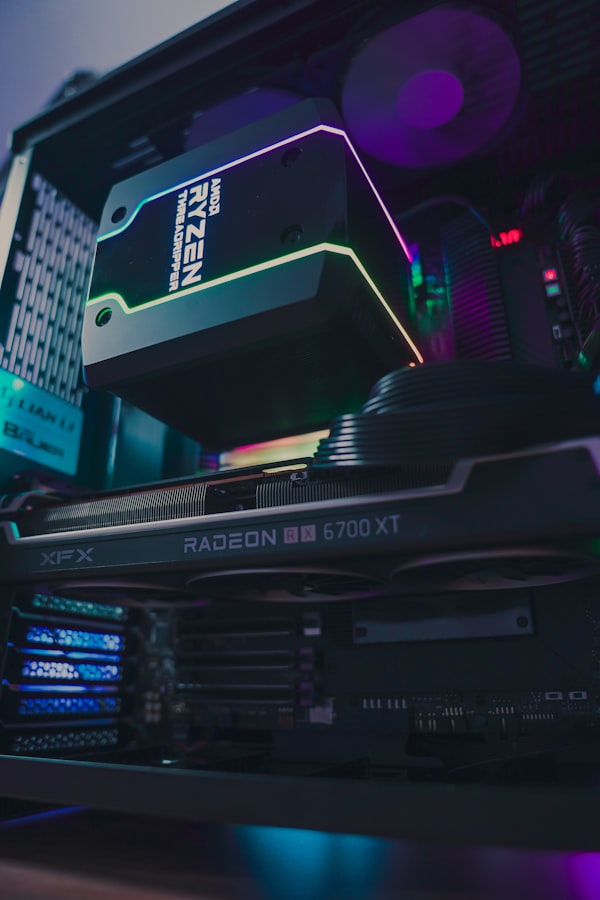Nvidia and AMD: Who Will Win the Tech Race?

Nvidia and AMD are two titans in the semiconductor industry, each with its own strengths and market focus. In 2024, both companies have shown significant developments in their respective areas, which has been reflected in their stock performance and market share dynamics.
Market Share and CPU Performance
AMD has made notable strides in the CPU market, reaching a new record in overall x86 CPU market share against its long-standing rival, Intel, in 2023. AMD's CPU share grew to 31.1 percent, while Intel’s decreased to 68.9 percent. However, it's important to note that AMD’s overall CPU share saw a decline both sequentially and year-over-year, settling at 28.6 percent, as Intel’s share grew to 71.4 percent. In the fourth quarter of 2023, AMD managed to grow its CPU share in desktop PCs to 19.8 percent against Intel’s 80.2 percent, and in laptops and other mobile devices to 20.3 percent against Intel’s 79.7 percent. These gains were attributed to AMD increasing CPU shipments for PCs faster than Intel.
Stock Performance and Revenue Growth
When comparing stock performance, Nvidia's shares surged by 252% in the past year, while AMD's shares gained 128% over the same period. Nvidia's revenue is expected to more than double from the previous fiscal year, reaching $59 billion, and its data center business could deliver $65 billion in revenue in fiscal 2025. AMD, on the other hand, is forecasted to see a 16.6% increase in revenue in 2024 to $26.4 billion, with earnings expected to increase by 41%.
AI and GPU Market Dynamics
In the AI sector, Nvidia has maintained its dominance with its GPUs becoming the go-to for AI developers, while AMD has been catching up with its MI300X AI GPU. Nvidia's stock has climbed over 200% year over year, thanks to its role in AI, while AMD has seen a 100% increase. The AI market itself is projected to expand at a CAGR of 37% through 2030.
In the GPU market, AMD offers budget-friendly options like the Radeon RX 7900 XTX, which appeals to budget-conscious gamers. Nvidia, however, leads in high-end performance with the GeForce RTX 4090. Both companies offer competitive products in the midrange market, with Nvidia's RTX 4070 standing out for performance, while AMD's RX 7800 XT offers better value.
Financial Metrics and Valuation
Nvidia is considered significantly cheaper than AMD in terms of forward and trailing earnings multiples. Nvidia's market cap stands at a staggering $1.98 trillion, dwarfing AMD's market cap of $311.09 billion. Nvidia's EPS is $11.95 compared to AMD's $0.54, and Nvidia's PE ratio is 66.20, while AMD's is much higher at 356.54.
Product Offerings and Consumer Preferences
Both AMD and Nvidia have their unique offerings that cater to different market segments. Nvidia often opts for proprietary technologies like DLSS 3, which are limited to its own platforms, while AMD tends to be more consumer-friendly with features that can be utilized on Nvidia cards as well. In the laptop market, Nvidia is preferred due to its dominance and advanced features offered by DLSS technology, while AMD lags in overall gaming laptop performance.
Innovation and Future Prospects
Both companies continue to innovate, with AMD introducing revolutionary APUs and a new graphics card, and Nvidia focusing on AI with technologies like Nvidia’s Ace and RTX Remix. Nvidia's unexpected change of strategy, offering better value in its new GPUs, has been well-received.
When comparing Nvidia (NVDA) and Advanced Micro Devices (AMD), several key points emerge from the analysis of their stock performance, market position, and future outlook:
Stock Performance
- Nvidia's stock has seen a significant rally, with a 250% year-to-date gain, overshadowing AMD's impressive 90% run-up[1].
- Over the last three months, Nvidia and AMD's performance has been quite similar, with Nvidia at a 49% gain and AMD at a 53% gain[2].
- Nvidia's stock is predicted to have a potential upside of 32.6%, while AMD is expected to see a loss of 3.6% over the next 12 months according to analysts[1].
Market Position and Revenue
- Nvidia dominates the data center GPU segment with a 92% market share, compared to AMD's 3%[2].
- Nvidia's data center revenue surged by 279% in Q3, while AMD's data center revenue was up 38% year-over-year in Q4 2023[1][2].
- Nvidia also holds an 80.2% market share in the discrete desktop GPU market[2].
Future Outlook and Valuation
- Nvidia is planning to launch new hardware tailored for the AI and HPC market, such as the H200 Tensor Core GPU[1].
- AMD's unveiling of the MI300, an AI GPU that claims to outperform Nvidia's H100, could potentially shift the competitive landscape[1].
- Nvidia's price-to-earnings ratio is expected to decrease from 270 in 2023 to 59.77 in 2024, while AMD's P/E ratio is estimated to go from 89.28 in 2023 to 60.84 in 2024[2].
- Analysts forecast Nvidia's total revenue to jump 56% in fiscal 2025 to $92 billion, with earnings expected to increase by 66%[3].
Analysts' Verdict
- Wall Street analysts favor Nvidia for its substantial upside potential compared to AMD[1].
- Nvidia is considered cheaper than AMD in terms of forward and trailing earnings multiples[3].
- The average price target for Nvidia's stock by the end of 2024 is $661.35, with the highest price target suggesting an upside of 121%[1].
- The average price target for AMD shares is $132.41, indicating a potential downside of 3.6%, with the most optimistic price target yielding an upside of 20% by the end of 2024[1].
Risk and Volatility
- Nvidia has a higher volatility of 18.40% compared to AMD's 17.39%, indicating that Nvidia's price experiences larger fluctuations[4].
In conclusion, while both Nvidia and AMD have shown strong stock performance, Nvidia appears to have a more dominant market position, particularly in the data center GPU segment, and is favored by analysts for its higher potential upside. However, AMD's recent developments and competitive pricing in the desktop segment also present a strong case for its future growth. Investors should consider these factors along with their risk tolerance and investment goals when evaluating the two stocks[1][2][3][4].
Citations:
[1] https://www.thestreet.com/memestocks/others/nvidia-stock-nvda-vs-amd-stock-amd-one-may-have-a-121-upside
[2] https://investing.com/analysis/amd-vs-nvidia-in-2024-which-ai-stock-makes-more-sense-for-your-portfolio-200645798
[3] https://www.fool.com/investing/2024/01/13/better-semiconductor-stock-nvidia-vs-amd/
[4] https://portfolioslab.com/tools/stock-comparison/NVDA/AMD
[5] https://youtube.com/watch?v=HTKPzFYRYNs



